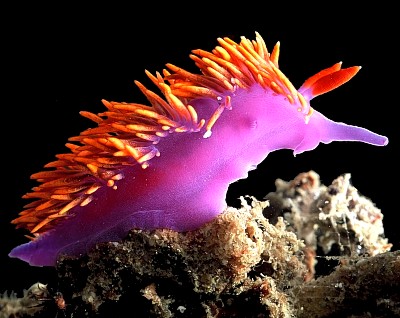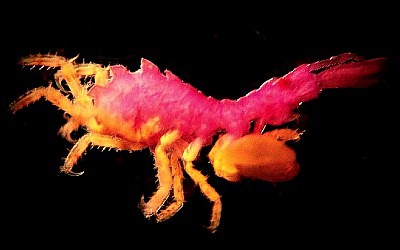

Flabellina iodinea
(Cooper, 1862)
Order: NUDIBRANCHIA
Suborder: AEOLIDINA
Family: Flabellinidae
DISTRIBUTION
Galapagos Islands to British Columbia, Canada.
PHOTO
UPPER: Santa Barbara County, California, subtidal. Photo: Todd Huspeni.
LOWER: amphipod crustacean mimic Podocerus cristatus, Diablo Canyon, San Luis Obispo County, central California. Photo: Mike Behrens.
Flabellina iodinea is one of the most visually stunning and common aeolids in southern and central California. It has been reported from off of Punta Asuncion, Baja California Sur, Mexico (Mulliner, 1982) to Vancouver Island, British Columbia, Canada (Bernard, 1970), but is rare north of San Francisco and has never been collected from the outer coast of Oregon and Washington. Flabellina iodinea has also been found at sites scattered throughout the Gulf of California, especially in deeper or colder waters (Bertsch & Kerstitch, 1984) and in the Galapagos Islands (Gosliner, 1991). It has the common name "Spanish Shawl".
Flabellina iodinea preys selectively on the orange polyps of the athecate hydroid Eudendrium ramosum (Engel, 1976; McDonald & Nybakken, 1978; personal observations). McBeth (1972) showed that the purple pigment in the body of F. iodinea, the orange color in its cerata, and the scarlet red in its rhinophores are all derived from a single carotenoid pigment, astaxanthin, obtained from its hydroid prey. In the aeolid, this pigment occurs in three slightly different states (free, esterified, and conjugated with a protein), resulting in the three distinct colors.
In central California, Gosliner & Behrens, (1990) reported a color variety of the amphipod crustacean Podocerus cristatus mimicking Flabellina iodinea. Another color variety of this same amphipod mimics F. trilineata on the central Oregon coast.
Flabellina iodinea lays bright pinkish orange colored egg ribbons, usually on the stalks of its hydroid prey. The eggs develop into planktotrophic veligers after 7 days at 14deg C (Engel, 1976; personal observations). When disturbed by potential predators such as seastars, Flabellina iodinea can lift off the substratum and swim away by flexing its body strongly and gracefully from side to side. (MacFarland, 1966; Farmer, 1970; personal observations). It grows to approx 70mm, and is found from the intertidal to approx. 40m deep.
References:
• Bernard, F. R. (1970) A distributional checklist of the marine molluscs of British Columbia: based on faunistic surveys since 1950. Syesis, 3:75-94.
• Bertsch, H. & A. Kerstitch. (1984) Distribution and radular morphology of various nudibranchs (Gastropoda: Opisthobranchia) from the Gulf of California, Mexico. The Veliger, 26: 264-273.
• Engel, C. P. (1976) The biology and life history of the nudibranch Flabellinopsis iodinea (Cooper, 1863). Ph.D. Dissertation, University of California, Santa Barbara, California.
• Farmer, W. M. 1970. Swimming gastropods (Opisthobranchia and Prosobranchia). The Veliger, 13: 73-89.
• Gosliner, T. M. 1991. The opisthobranch gastropod fauna of the Galapagos Islands. Pp. 281-305 [in] M. J. James (ed.), Galapagos marine invertebrates: taxonomy, biogeography, and evolution in Darwin's islands. Plenum Press: New York.
• Gosliner, T.M. & D.W. Behrens. (1990) Special resemblance, aposematic coloration, and mimicry in opisthobranch gastropods. Pp. 127-138 [In] M. Wicksten (ed.) Adaptive coloration in invertebrates. Texas A & M University Sea Grant Program: College Station, Texas, USA.
• McBeth, J. W. 1972. Carotenoids from nudibranchs. Comparative Biochemistry and Physiology, 41(B): 55-68.
• MacFarland, F. M. 1966. Studies of opisthobranchiate mollusks of the Pacific coast of North America. Memoirs of the California Academy of Sciences, 6: 1-546.
• McDonald, G.R. & J.W. Nybakken. (1978) Additional notes on the food of some California nudibranchs with a summary of known food habits of California species. The Veliger, 21(1):
110-119.
• Mulliner, D. (1982) Personal notes, from Dave Mulliner. Opisthobranch Newsletter, 14: 2.
Goddard, J.H.R., 2000 (July 1) Flabellina iodinea (Cooper, 1862). [In] Sea Slug Forum. Australian Museum, Sydney. Available from http://www.seaslugforum.net/factsheet/flabiodi
Related messages
-
Re: Flabellina iodinea mating
From: Jonathan S. Klenk, August 19, 2009 -
Re: Flabellina iodinea feeding
From: Roger Carlson, May 16, 2007 -
Flabellina iodinea from Bahia California
From: Natasja Vandeperre, May 16, 2007 -
Flabellina iodinea feeding
From: James Lyle, February 2, 2007 -
Re: Flabellina iodinea mating
From: James Lyle, September 17, 2005 -
Re: Flabellina iodinea mating
From: James Lyle, September 15, 2005 -
Flabellina iodinea laying eggs
From: Chris Menjou, September 23, 2003 -
Flabellina iodinea feeding on hydroids
From: Bruce Wight , August 5, 2003 -
Flabellina iodinea from California
From: Chris Grossman, July 31, 2003 -
Flabellina iodinea mating
From: Gaby Chavez, March 22, 2003 -
Spanish Shawl Nudibranch
From: Chase Walden, February 6, 2003 -
Spanish Shawl Dancer
From: Anna, November 20, 2001 -
Reproduction in Flabellina iodinea
From: Jennifer , October 31, 2001 -
Flabellina iodinea laying eggs
From: Michael D. Miller, August 6, 2001 -
Flabellina iodinea from California
From: Daniel Geiger, August 3, 2001 -
Flabellina iodinea
From: Brett Maton, April 20, 2001 -
Flabellina iodinea and mimic
From: Jeff Goddard, July 2, 2000
